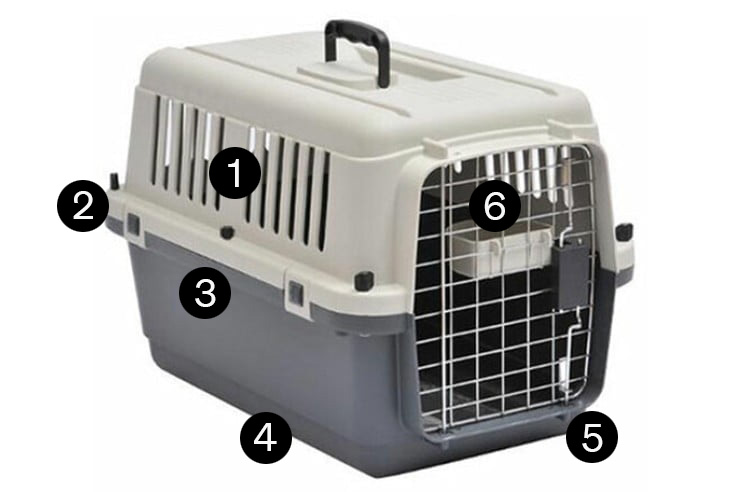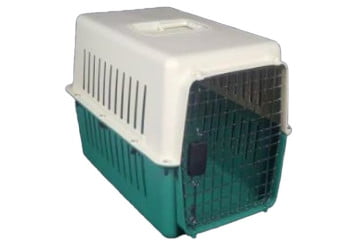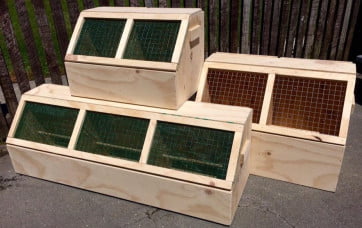Travelling with pets
Cats, dogs and small caged birds can travel as checked-in baggage on all domestic flights around New Zealand provided they fly in pet carriers suitable for air travel.
- 1
Add your pet to your domestic flight booking
If you have a domestic flight booked with Air New Zealand, please complete this form to request that your pet is added to your booking. You will need the following information:
- Your six-character booking reference (found on your flight confirmation emails and itinerary)
- Pet name
- Pet age
- Pet type
- Weight of pet
- Weight of pet's carrier
- Your contact details
If your booking is for a regional route and includes more than one pet carrier per person, you'll need to pre-book your pets to travel as cargo due to the space limitations of our smaller turbo-prop aircraft.
Weigh your pet and the carrier
To help us plan for your pet's travel, we need to know the weight of your pet (to the nearest kilogram) as well as the weight of your pet's carrier. If in doubt, it's best to round upwards so that we can have accurate information for our loading teams.
See how much it costs
The pet carriage fee is payable at the airport and reflects the special treatment required to ensure the safety of your pet.
How much you need to pay depends on the size of your pet.
Book an extra bag (if needed)
To help us calculate and plan for your pet's travel in the hold, we consider your pet's checked-in carrier as part of your baggage allowance.
Tip: when booking your flight, look for a fare with baggage allowance.
- 2
Prepare your pet's travel carrier
We will not accept carriers where the animal is unable to naturally stand, sit up, turn around and lay down.
For your pet's comfort and safety during their flight, all pets must travel in carriers that meet the current standards approved by the International Air Transport Association (IATA).
Get the right carrier size and set-up for your pet:
- When standing outside the carrier, no part of your pet should be taller or longer than the carrier.
- When inside the carrier, they shouldn't have to duck to see out of the carrier door. The carrier should also be wide enough for your pet to turn around easily and long enough for them to lie down comfortably with their paws extended.
- The carrier must be fitted with a small water container that is fillable from the outside of the carrier.
- For your pet's comfort and to avoid mess, the carrier floor must be lined with absorbent material such as paper, shredded newspaper or puppy pee pad.
- If the carrier does not meet our size and construction requirements, we will not accept the pet to board on your flight, and it may need to be rebooked for a later flight or day of travel, which could incur additional expenses.
Animals per carrier
If you're travelling with more than one pet in a carrier, you need to meet these requirements:
Familiarise your pet with the carrier
Ideally, your pet should be familiarised with their travel carrier at least two weeks before travel. This will help your pet feel more secure and comfortable, and reduce anxiety levels for both you and your pet.
- 3
On the day of the flight
Help your pet get ready to travel
After checking that your pet looks healthy and fit for travel, it's time to get ready for the flight.
Before check-in
Please arrive at the airport 60 minutes prior to your flight's departure. If you haven't checked in online already, please check in passengers before taking your pet to either the Special Assistance or Oversized Baggage counter (depending on the airport).
Staff will then check that the pet's carrier meets the requirements and the pet and carrier will be weighed and payment taken.
Important: we may refuse your pet's travel if the carrier does not meet the size and construction requirements.
Remember that every airport has a different configuration of where to take your pet for check-in and regulations on how your pet can arrive at the airport.
After your pet has been checked in
The Air New Zealand ground staff who load the pets onboard at the departure airport and unload at the arrival airport are trained in pet travel and will do what they can to minimise stress for your furry or feathered friend.
Arrival and pick up
Your pet will be carried into the baggage arrival area by one of our team. This may be before, during or after other baggage has been delivered to the baggage claim area, depending on the airport.
To be mindful of other passengers and airport regulations, please do not let your pet out of its carrier until you have left the terminal building.
Select the right travel carrier for your pet
Air New Zealand carries animals in accordance with the current standards published in the IATA Live Animal Regulations.
| Permitted | Not permitted | |
|---|---|---|
| Construction of cat or dog carrier | ✔ Fibreglass, metal, rigid plastic, welded metal mesh, solid wood, and plywood carriers ✔ Ventilation holes are only permitted on the upper half of three sides, excluding the door. See example ✔ The door must be open and covered with welded mesh, bars etc., nose and paw-proof ✔ The door must form the whole of one end of the carrier (can be sliding or hinged) and can't be accidentally opened ✔ The floor must be solid and leak-proof and the interior must be smooth with nothing sticking out ✔ Spacer bar must be fitted in the middle on three sides (not the door). Handles should allow easy carriage of the carrier ✔ Wheels are permitted but must be removed or inoperable when carried ✔ Water container must be fitted in the carrier | ✘ Entirely welded mesh, open wire, pop-up hatch style carriers ✘ Ventilation on the upper and lower sides of a carrier |
| Door locking and latching | ✔ The top and bottom of a plastic carrier must be fixed together using either 'bolt tightened' or another 2-step method e.g. screw & dial ✔ Minimum fasteners include one at each corner and at least 1 down each side, carriers longer than 60cm must have minimum of 2 fasteners each side ✔ Door hinge & locking pins on rigid plastic carriers must engage the carrier by at least 1.6cm beyond the horizontal extrusion above and below the door opening ✔ Cable ties must be attached to all four corners of the carrier's door to prevent it from being prised open by the animal | ✘ Latches fixing the top and bottom of plastic carrier ✘ Restraint straps etc., securing a carrier ✘ Doors that have a 'twist clip' around the locking pins |
| Inside the carrier | ✔ You must include appropriate and proportionate absorbent material e.g. paper, shredded newspaper or puppy pee pad ✔ You can include a blanket in the carrier ✔ Please ensure your pet has had food and water prior to travelling | ✘ Important: No food or toys are permitted in, or attached to, the carrier. |
| Use of cable ties | ✔ Airport staff may use a cable tie as a secondary means of securing a cage and preventing accidental opening. | ✘ Must not be applied through ventilation holes ✘ Must not be cut short as they pose a risk of injury to your pet |
Cat and dog carriers
Construction of cat or dog carrier
✔ Fibreglass, metal, rigid plastic, welded metal mesh, solid wood, and plywood carriers
✔ Ventilation holes are only permitted on the upper half of three sides, excluding the door. See example
✔ The door must be open and covered with welded mesh, bars etc., nose and paw-proof
✔ The door must form the whole of one end of the carrier (can be sliding or hinged) and can't be accidentally opened
✔ The floor must be solid and leak-proof and the interior must be smooth with nothing sticking out
✔ Spacer bar must be fitted in the middle on three sides (not the door). Handles should allow easy carriage of the carrier
✔ Wheels are permitted but must be removed or inoperable when carried
✔ Water container must be fitted in the carrier
✘ Entirely welded mesh, open wire, pop-up hatch style carriers
✘ Ventilation on the upper and lower sides of a carrier
Door locking and latching
✔ The top and bottom of a plastic carrier must be fixed together using either 'bolt tightened' or another 2-step method e.g. screw & dial
✔ Minimum fasteners include one at each corner and at least 1 down each side, carriers longer than 60cm must have minimum of 2 fasteners each side
✔ Door hinge & locking pins on rigid plastic carriers must engage the carrier by at least 1.6cm beyond the horizontal extrusion above and below the door opening
✔ Cable ties must be attached to all four corners of the carrier's door to prevent it from being prised open by the animal
✘ Latches fixing the top and bottom of plastic carrier
✘ Restraint straps etc., securing a carrier
✘ Doors that have a 'twist clip' around the locking pins
Inside the carrier
✔ You must include appropriate and proportionate absorbent material e.g. paper, shredded newspaper or puppy pee pad
✔ You can include a blanket in the carrier
✔ Please ensure your pet has had food and water prior to travelling
✘ Important: No food or toys are permitted in, or attached to, the carrier.
Use of cable ties
✔ Airport staff may use a cable tie as a secondary means of securing a cage and preventing accidental opening.
✘ Must not be applied through ventilation holes
✘ Must not be cut short as they pose a risk of injury to your pet
For other useful information about pet carrier requirements, please visit IATA's pet corner page.
Example of approved pet carrier for air travel

- Adequate ventilation on the upper section of three sides (not including the door)
- Top and bottom fixed together e.g. tightened bolt and screw at each corner. Minimum of 1 fixing on sides for carriers under 60 cm; minimum of 2 if carrier exceeds 60 cm
- Space bar fitted on three sides
- Leak-proof floor
- Locking pins must extend a minimum of 1.6 cm into the top and bottom lips
- Water container

Example of unsuitable pet carrier
✘ This pet carrier will not be accepted for air travel as it has ventilation holes on the lower half of the carrier's sides and does not include a water container.

Travel cages and carriers for birds
Your bird/s may travel in a bird travel carrier, or size-appropriate cat/dog carrier may be used, provided the required perch/perches are fitted.
Perches
For birds that rest by perching, the carrier must include round perches that:
- are large enough for the birds to grip firmly and comfortably (relevant to the species)
- allow for all birds (if more than one) to perch comfortably at the same time
- are placed so droppings do not fall into food or water troughs
- are placed at such a height that the birds can leave the perch without their heads contacting the roof, nor the tail with the floor while perching
- are not placed too high within the carrier for the birds to become upset during transport.
For parrots (psittacine), that do not rest by perching, suitably sized smooth rails fixed to the floor must be provided so that the birds can feel secure.